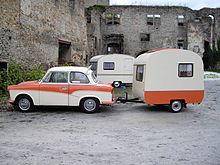Weferlinger home pride
Weferlinger is the slang term for several caravan models from the GDR , which were manufactured in the Heimstolz craft production cooperative in the Weferlingen district ( Haldensleben district ). Despite their different sizes, the individual LC models are clearly similar in terms of their design. The designer of the LC9-200 and the LC9-285 was Wilhelm Luther from Birken Werden. The abbreviation “LC” in the model name stands for “Luther Camping”.
construction
Outside
White synthetic resin varnish protects the boil-proof glued veneer panels from the outside. The side parts are double-walled. The PGH Heimstolz caravans have a window on each side. The window at the front in the direction of travel can be opened outwards. The entrance door is divided in the middle. For example, only the upper part of the door in connection with the window can be opened when cooking. The roof center section, which can be opened and fitted with a fly screen, ensures air circulation. The wheels are mounted on semi-axles, on which simple rubber blocks ensure a comparatively modest suspension. The chassis is therefore maintenance-free.
The trailer stands securely on the two wheels, supported by four stands with trapezoidal thread spindles, even on uneven locations. The tires and wheels of size 3.50 - 12 ″ - 1.5 at are the same as on the Troll scooter .
The awning can be set up in around ten minutes. After threading the piping into the circumferential aluminum piping rail on the right-hand side of the car, the frame is assembled and placed under the awning. The tent gable side (the entrance door) can also be set up as a sun roof.
Inside
The entire interior of all caravans is made of Finnish real wood, which was used for weight reasons. There is a large wardrobe in each car. A sensible room layout is essential, especially with the interior dimensions of the small "Wefi". In less than a minute, the folded table top and a support bar have become a bed area of 1.95 × 1.12 m . Under the bench there is storage space for blankets, pillows and bedding. A two-burner propane gas cooker , which is supplied by a 2 kg propane gas bottle, which is housed in the interior, serves as cooking facilities.
The interior lighting is provided by two 5-watt festoons , fed by the car battery, or a 25-watt candle lamp with a 230-volt supply.
Models
LC9-200
The "little" Weferlinger. It was specially developed for the Trabant .
| Net weight | 220 kg / 250 kg |
| Payload | 60 kg / 30 kg |
| Body length | 2.00 m |
| width | 1.63 m |
| Height from the ground | 2.03 m |
| Headroom | 1.80 m |
Currently, the little Weferlinger (in addition to the Qek Junior ) also enables drivers of trikes , smarts , ducks and other small cars to vacation with a caravan.
LC9-285
The "big" Weferlinger. It was developed for larger vehicles than the Trabant (e.g. Wartburg 353 ).
| Net weight | 350 kg |
| Payload | 100 kg |
| Body length | 2.85 m |
| width | 1.84 m |
| Height from the ground | 2.10 m |
| Headroom | 1.87 m |
Every 300
In 1983, the “Aller 300” was a completely new design.
| Net weight | 400 kg |
| Payload | 150 kg |
| Body length | 3.00 m |
| width | 1.98 m |
| Height from the ground | 2.31 m |
| Headroom | 1.84 m |
This new car was built in the VEB Heimstolz Weferlingen (in the VEB Kombinat vehicle construction and accessories Kakerbeck). Recognizable by its angular shape, this caravan offers plenty of space and comfort compared to its predecessors.
All 340
The “Aller 340” is the largest caravan ever produced in series from the “VEB Heimstolz Weferlingen” company.
| Net weight | 450 kg |
| Payload | 100 kg |
| Body length | 4.15 m |
| width | 2.00 m |
| Height from the ground | 2.31 m |
| Headroom | 1.97 m |
Web links
- weferlinger.de - Website and forum for the Weferlinger caravan





